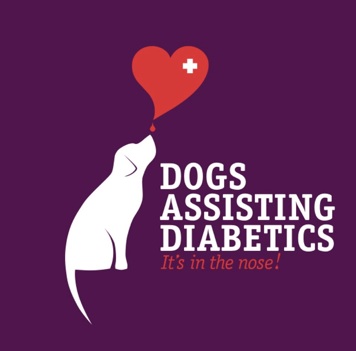WHAT IS A DOGS ASSISTING DIABETICS FOUNDATION DIABETIC ALERT SERVICE DOG?
Dogs Assisting Diabetic Foundation Diabetic Alert Service Dogs are trained using positive reinforcement to detect the chemical change a person’s bod goes through when experiencing a high or a low blood sugar level.
It is not known for certain what the dogs are smelling, but the process for training works, nonetheless. By using clickers, lots of treats and lots of fun, the dogs find training for scent work more of a game than a job. The dogs learn to associate the scent of a high or low blood sugar level with treats and affection.
Once trained, a diabetic alert service dog is able to detect both a high and a low blood sugar level. The dog will perform a trick behavior such as a circle or a bow, to indicate the change in blood sugar levels. The dogs are also trained to retrieve certain objects which signal the handler to check blood sugar levels. At night or in the car, The dogs will ring wireless doorbells to alert their handlers.
Dogs Assisting Diabetics has the help of many volunteers to make this program possible. The puppy raisers keep a dog in their home and train him/her to be successful in public access an house manners. These raisers also attend regular, weekly meetings to advance the puppy in scent training with the Director of Training. It is thought that this is the most important work in the Foundation because, without the love and diligent work these handlers provide the puppies, there would not be a program.
Fundraising is also a very important part of this Foundation. Being a 501(c)(3) non-profit, Dogs Assisting Diabetics depends on the generosity of others to keep this program alive and successful. This is done through private donations of money, puppies, supplies or support at events like our annual walk or workshops. Even if you do not have diabetes, the likelihood someone you love and are close to, is living with this disease, is great. The donations to Dogs Assisting Diabetics makes it even more likely that this Foundation will be able to provide a gift that not only assists with maintaining blood sugar levels but also provides a sense of independence and security.
For more information on obtaining a service dog or to donate, contact Dogs Assisting Diabetics at
info@dogsassistingdiabetics.com
WHAT IS A SERVICE DOG?
The American Disability Act (ADA) defines a service animal as any guide dog, signal dog, or other animal individually trained to provide assistance to an individual with a disability. If they meet this definition, animals are considered service animals under the ADA regardless of whether they have been licensed or certified by a state or local government.
Service animals perform some of the functions and tasks that the individual with a disability cannot perform for him or herself. Guide dogs are one type of service animal, used by some individuals who are blind. This is a type of service animal with which most people are familiar. But there are service animals that assist persons with other kinds of disabilities in their day-to-day activities. Some activities include:
Alerting persons with hearing impairments to sounds.
Pulling wheelchairs or carrying and picking up things for persons with mobility impairments.
Assisting persons with mobility impairments with balance.
A service animals is not a pet.
If you have further questions about service animals or other requirements of the ADA, you may call The U.S. Department of Justice’s toll-free ADA Information Line at 800-514-0301 (voice) or 800-514-0383 (TDD).
Visit the ADA webpage at www.ADA.gov
For a frequently asked question Service Dog sheet visit http://www.ADA.gov/qasrvc.htm
WHAT IS DIABETES?
Diabetes Affects 25.8 Million People,
8.3% of the U.S. Population
Type I diabetes was previously called insulin-dependent diabetes mellitus (IDDM) or juvenile- onset diabetes. Type I diabetes develops when the body’s immune system destroys pancreatic beta cells, the only cells in the body that make the hormone insulin that regulates blood glucose. To survive, people with type I diabetes must have insulin delivered by injection or a pump. This form of diabetes usually strikes children and young adults, although disease onset can occur at any age. In adults, type I diabetes accounts for approximately 5% of all diagnosed cases of diabetes. Risk factors for type I diabetes may be auto immune, genetic, or environmental. There’s no known way to prevent type I diabetes. Several clinical trials for preventing type I diabetes are currently in progress or are being planned.
Type II diabetes was previously called non-insulin-dependent diabetes mellitus (NIDDM) or adult-onset diabetes. In adults, type II diabetes accounts for about 90% to 95% of all diagnosed cases of diabetes. It usually begins as insulin resistance, a disorder in which the cells do not use insulin properly. As the need for insulin rises, the pancreas gradually loses its ability to produce it. Type II diabetes is associated with older age, obesity, family history of diabetes, history of gestational diabetes, impaired glucose metabolism, physical inactivity, and race/ethnicity. African Americans, Hispanics/Latino Americans, American Indians, and some Asian Americans and Native Hawaiians or other Pacific Islanders are at a particularly type II diabetes and its complications. Type II diabetes in children and adolescents, although still rare is being diagnosed more frequently among American Indians, African Americans, Hispanic/Latino Americans and Asian/Pacific Islanders.
Information from: http://www.cdc.gov/diabetes/pubs/pdf/ndfs_2011.pdf
For more information on diabetes, please visit the following sites:
http://www.ohsu.edu/xd/health/services/diabetes/
https://www.virginiamason.org/dept.cfm?id=375
Dogs Assisting Diabetics Foundation is a501(c)(3) non-profit.



